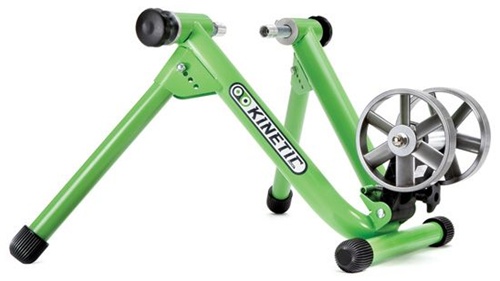Wind Trainer – aka Fan Trainer – aka Air Trainer
A wind trainer is a type of indoor bike trainer that uses a fan or wind resistance mechanism to provide resistance while cycling.
As you pedal, the fan creates air resistance, which increases as you go faster.
Wind trainers are known for their simplicity and affordability, making them a popular choice for casual riders and those on a budget.
While wind trainers have been around for a long time, they are still a viable option for indoor cycling. However, they may not offer the same advanced features, precise resistance control and realistic riding experience as modern smart trainers.
It ultimately depends on your preferences and specific training goals.
| PROS Of The Wind Trainer | CONS Of The Wind Trainer |
|---|---|
|
|
The Case FOR a Wind Trainer (Pros)
Wind trainers offer several advantages that make them a popular choice for indoor cycling enthusiasts.
Here are the expanded details of their pros:
Simple and Cost-Effective Solution
Wind trainers provide a straightforward and budget-friendly option for indoor training. They don’t rely on complex technologies or electronic components, which keeps the cost relatively low.
Natural and Progressive Resistance
Wind trainers utilize a fan-like mechanism that creates resistance as you pedal. The resistance increases with your pedaling speed, simulating the feeling of riding outdoors. This progressive resistance allows for a more challenging workout as you increase your effort.
No External Power Source or Connectivity Required
Wind trainers operate purely based on the airflow generated by your pedaling. They don’t require any external power source or connectivity to function, making them easy to use and set up. You can start your training session immediately without worrying about cables or batteries.
Durability and Low Maintenance
Wind trainers are known for their durability and longevity. They have a simple design with fewer moving parts, which reduces the likelihood of mechanical issues. Additionally, they require minimal maintenance, typically limited to keeping the unit clean and occasionally lubricating the moving parts.
Compatibility with Different Bike Types
Wind trainers are compatible with various types of bikes, including road bikes, mountain bikes, and hybrid bikes. This versatility allows riders to use their preferred bike for indoor training without the need for additional equipment or adapters.
Consistent and Reliable Resistance
Wind trainers provide a consistent resistance that closely mimics outdoor riding conditions. As you pedal, the fan generates airflow, creating resistance that remains steady throughout your workout. This consistency allows for a more realistic and predictable training experience.
Affordability
Compared to other types of trainers on the market, wind trainers are generally more affordable. Their simpler design and fewer components contribute to their cost-effectiveness, making them an attractive option for budget-conscious cyclists.
Lightweight and Portable
Wind trainers are typically lightweight and easy to transport. Their compact design allows for easy storage when not in use, making them suitable for those with limited space. You can conveniently set up your wind trainer in different locations or take it with you for training while traveling.
Cardiovascular Workout and Endurance Building
Wind trainers offer an effective cardiovascular workout, helping to improve your heart and lung health. They provide resistance that challenges your muscles and increases your endurance and stamina over time.
Suitable for All Fitness Levels
Wind trainers are suitable for riders of all fitness levels. Whether you’re a beginner starting your fitness journey or an experienced cyclist looking to maintain or improve your performance, a wind trainer can accommodate your needs and provide an effective training experience.
The Case AGAINST a Wind Trainer (Cons)
While wind trainers have several advantages, it’s important to consider the following potential drawbacks:
Noise Level
Wind trainers can generate significant noise due to the spinning fan. The sound can be loud and disruptive, which may not be ideal if you prefer a quieter training environment or if you live in a shared space.
Lack of Adjustable Resistance
Unlike some other types of trainers, wind trainers don’t typically offer adjustable resistance levels. The resistance is solely determined by the speed at which you pedal. This limited adjustability may not provide the same level of fine-tuned intensity control as trainers with adjustable resistance settings.
Less Realistic Road Feel
While wind trainers simulate outdoor riding by creating resistance through the fan, they may not provide the same realistic road feel as other types of trainers, such as fluid or smart trainers. The resistance generated by the fan doesn’t precisely mimic the varied terrain or road conditions experienced during outdoor cycling.
Limited Training Features
Wind trainers generally lack advanced training features and connectivity options found in smart trainers or virtual reality trainers. They may not offer features like power measurement, connectivity with training apps or software, or the ability to simulate virtual routes or races.
Heat Generation
Wind trainers can generate heat as a byproduct of the fan spinning. Prolonged use may lead to increased heat buildup, which could affect your comfort or potentially impact the longevity of the trainer if not properly ventilated.
Less Smooth Pedaling Experience: The resistance generated by the fan can create a slightly less smooth pedaling experience compared to other types of trainers. This may be noticeable during high-intensity efforts or when aiming for a consistent pedal stroke.
Limited Compatibility with Wheel Sizes
Some wind trainers may have limitations when it comes to accommodating certain wheel sizes or tire widths. It’s important to check the specifications of the specific wind trainer model to ensure compatibility with your bike.
Resistance Limitations at Higher Speeds
Wind trainers may have limitations in providing high resistance at higher pedaling speeds. As the fan spins faster, the resistance can reach a peak and may not increase significantly beyond that point, limiting the ability to perform high-intensity sprints or simulate fast downhill sections.
Less Precision in Power Measurement
Wind trainers generally don’t provide precise power measurement capabilities like some smart trainers or power meters. If precise power data is essential for your training or performance tracking, a wind trainer may not be the most accurate option.
External Factors Influence Resistance
Wind trainers are susceptible to external factors such as wind direction and intensity. Changes in air temperature and wind speed can affect the resistance experienced during your workout, which may not provide consistent training conditions.
Considering these potential drawbacks can help you make an informed decision when choosing a trainer that aligns with your specific needs, preferences, and training goals.
Wind Trainer vs Magnetic Trainer vs Fluid Trainer
When comparing wind trainers to magnetic trainers and fluid trainers, there are several key factors to consider:
Resistance Mechanism
Wind trainers generate resistance through a spinning fan, while magnetic trainers use magnets to create resistance, and fluid trainers utilize fluid chambers.
Wind trainers provide a progressive resistance that increases with your pedaling speed, while magnetic and fluid trainers offer adjustable resistance settings.
Noise Level
Wind trainers can be noisier compared to magnetic and fluid trainers. The spinning fan creates airflow and can produce noticeable noise during use.
Magnetic trainers tend to be quieter, with the only noise coming from the bike itself, while fluid trainers are generally the quietest due to the fluid’s dampening effect.
Realism and Road Feel
Fluid trainers are often praised for their realistic road-like feel. The fluid resistance mimics the sensation of riding on the road, with a smooth and progressive resistance curve.
Magnetic trainers can also provide a good road feel, especially models with advanced magnetic resistance systems.
Wind trainers, on the other hand, may not offer the same level of realism due to the constant resistance generated by the fan.
Adjustability
Magnetic trainers and fluid trainers typically provide more precise resistance control and adjustability compared to wind trainers. They often have multiple resistance levels or adjustable settings that allow you to fine-tune the intensity of your workout.
Wind trainers, being reliant on the speed of the fan, have less adjustability in terms of resistance.
Price
Wind trainers are generally more affordable compared to magnetic and fluid trainers. If budget is a significant consideration, a wind trainer may be a cost-effective option for basic indoor cycling workouts.
Compatibility
Wind trainers, magnetic trainers, and fluid trainers are compatible with most standard road bikes and mountain bikes. However, it’s essential to ensure compatibility with your specific bike’s wheel size, axle type (quick release or thru-axle), and rear dropout spacing.
Ultimately, the choice between a wind trainer, magnetic trainer, or fluid trainer depends on your specific needs, preferences, and budget.
If you’re looking for a budget-friendly option and don’t require advanced resistance control, a wind trainer can be a suitable choice.
Magnetic trainers offer more adjustability and versatility, while fluid trainers are known for their realistic road feel.
Consider your training goals, desired resistance options, noise tolerance, and budget when making a decision.

